Risen 2: Dark Waters – Full Preview
by Mark R
Under normal circumstances, two weeks with a preview copy of a typical modern (Western) RPG would result in a high level character that could make walls bleed and ancient gods beg for mercy before the hero had even unsheathed their sword. As with its predecessor, Risen 2: Dark Waters is no such game. Sure, it has the role playing elements that you’d expect such as a skill tree and the option to focus on specific attributes, a hefty inventory system, enchanted weapons here and there, as well as the odd legendary item… but don’t expect that any of these will make your journey any easier. They won’t. Piranha Bytes return with another punishing RPG that makes you fight for your rewards, struggle to survive, and pay through the nose for advancement. Good.
Following their tradition of direct sequels, Piranha Bytes once again shoe-horns the player into the boots of the protagonist from the original Risen who, as a result of everything he’d gone through in the previous story, is now spending more time gazing into an empty bottle than a spyglass. The customary pirate eye-patch covers the Oculus that was taken from Mendoza in order to defeat the Titans, allowing him to blend in well to his pirate surroundings, and that’s exactly what you are tasked to do as the story begins. Starting off in Caldera, our hero is part of the Inquisition and told of how a great Kraken has been taking down ships in the area and, upon witnessing a wreck for himself, is asked to investigate the beach to recover detritus and search for survivors before attempting to infiltrate the local pirate faction in order to learn more about the origins of the sea creatures, with the ultimate goal of driving them away from the islands or destroying them altogether.
It is at this point where we meet, once again, the barmaid from the original Risen game, and daughter of the much-feared and respected pirate Captain Steelbeard that we dealt with briefly in the previous release. The character of Patty has changed considerably from the previous title and is not only less tomboyish and far more feminine, but has also lost a lot of the sassiness that made her alluring in the first place, and her brazen approach to life has been replaced by a more playful attitude. The personality change was one which could be overlooked as I’m sure it will adapt to suit circumstances as the story unfolds, but I can’t help but think the aesthetic changes do the character something of a disservice. Regardless, Patty’s own subplot warrants her tagging along as you embark on your journey and, to be perfectly honest, you need a wingman… or woman… in the early stages of the game if you want to stay alive.
 Having Patty on-side makes it easier to convince the pirates that you can be trusted, which is just as well as you need their help in order to put an end to the watery carnage. It turns out that Steelbeard is aware of the two weapons required to kill the Kraken, and that they were given to a pirate by the name of Captain Crow, by the Titan lord Mara, and so the initial leg of the journey involves convincing Steelbeard to let you join his crew and take to the seas in search of Crow who, we discover, has sided with the savages on a neighbouring island and getting past their voodoo will be no easy task.
Having Patty on-side makes it easier to convince the pirates that you can be trusted, which is just as well as you need their help in order to put an end to the watery carnage. It turns out that Steelbeard is aware of the two weapons required to kill the Kraken, and that they were given to a pirate by the name of Captain Crow, by the Titan lord Mara, and so the initial leg of the journey involves convincing Steelbeard to let you join his crew and take to the seas in search of Crow who, we discover, has sided with the savages on a neighbouring island and getting past their voodoo will be no easy task.
When we spoke with Deep Silver’s then Brand Manager, Daniel Oberlerchner, at Gamescom last year, we asked if the punishing difficulty that we’d come to expect from Piranha Bytes would be as apparent in Dark Waters and, much to our surprise and dismay, we were told that the difficulty would ramp up as the game progressed but that the initial island would be very easy to complete and was more of a tutorial to ease players into the gameplay mechanics. What Daniel didn’t say, however, was that the time on the first island could quite easily come to a close in a matter of minutes unless you opted to spend a lot of time exploring the beaches. As soon as the first few tasks are taken care of, we wave a fond farewell to the familiar shores of Caldera and take to the sea toward the unknown territory of Tacarigua.
 |
 |
 |
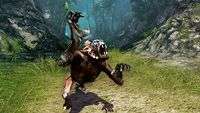 |
 |
 |
Tacarigua is, to all intents and purposes, a tropical island which has been left mostly untouched by the outside world. A few clusters of buildings are scattered here and there throughout the map, peppering the vast jungle terrain and it becomes apparent very early on that we are no longer in the safe haven of the tutorial level, and that the aforementioned difficulty ramp is almost vertical. As you’d expect from the people responsible for the Gothic series, the AI enemies of Dark Waters take no prisoners. No sooner have you spotted a warthog snuffling around in the undergrowth than you’ll have perhaps three or four of them attacking you all at once and, with an unforgiving levelling system, this is never an easy situation to deal with.
 The combat in the earlier stages of the game is somewhat restricted and, sadly, involves nothing more than continually clicking the same button over and over in the general direction of whichever enemy you wish to attack. While it may be unimaginative, it serves its purpose as you’ll almost certainly have your hands full having to deal with the myriad of attacking enemies without also having to worry which combo moves you’re going to throw out. As you progress through the game, however, you have the opportunity to learn new skills within each of the various disciplines, opening up more advanced moves with which to impress onlookers and take down foes.
The combat in the earlier stages of the game is somewhat restricted and, sadly, involves nothing more than continually clicking the same button over and over in the general direction of whichever enemy you wish to attack. While it may be unimaginative, it serves its purpose as you’ll almost certainly have your hands full having to deal with the myriad of attacking enemies without also having to worry which combo moves you’re going to throw out. As you progress through the game, however, you have the opportunity to learn new skills within each of the various disciplines, opening up more advanced moves with which to impress onlookers and take down foes.
As with Risen, it’s rare that you’ll find anyone stand by and watch while your character is ripped limb from limb and, if they happen to have a weapon to hand at the time, anyone in the immediate vicinity will almost certainly wade in to help overcome your attacker but it’s important to point out that, in doing so, the passers by will invariably find themselves in the cross fire at one point or another, and so it’s vital that you pay particular attention to each blow otherwise you’ll be coming out of one fight and straight into another.
The term “cross fire”, when describing general combat confusion above is particularly apt terminology as Risen 2 takes a daring, and sizeable, sidestep away from the traditional role playing fantasy staple of swords, shields, longbows, and the occasional crossbow, by introducing firearms to the available arsenal. With the guns staying true to their period, there is no frantic crosshair action as you unload clip after clip into oncoming enemies and, instead, each gun has its own considerable cooldown and reload time depending on the class of weapon. Boarding pistols, for example, fire a single shot and can have a massive thirty second cooldown period before being allowed to fire the next shot which, in most circumstances, is almost pointless unless you’re carrying several and can quickly switch between them to avoid the wait. Shotguns, on the other hand, have a much shorter wait between shots but this is countered by the fact that you need to be considerably closer to the enemy in order to take full advantage of the damage spread, otherwise your shot is bound to miss entirely.
 As someone who would traditionally opt for close-quarter melee fighting over ranged combat, it was tempting to overlook the new weapons and stick with the comfort of the blade, but the opportunity was too good to pass up and so I squandered what little ill-gotten gains I had in an effort to lure myself to the dark side. It has to be said that, depending on the enemy, the shotgun did help get through some particularly sticky situations relatively unscathed. Against a pack of warthogs or claw monkeys, you’re taking your life in your hands if you think that even the shortest reload time will be enough to get you through, invariably resulting in your being shredded to pieces. If, however, we’re looking at situations where you have only one enemy and are able to move backwards as they continue to advance, then they do the job perfectly and do actually add an air of anticipation as you watch the cool-down meter and hope that you can fire off another round before the next attack.
As someone who would traditionally opt for close-quarter melee fighting over ranged combat, it was tempting to overlook the new weapons and stick with the comfort of the blade, but the opportunity was too good to pass up and so I squandered what little ill-gotten gains I had in an effort to lure myself to the dark side. It has to be said that, depending on the enemy, the shotgun did help get through some particularly sticky situations relatively unscathed. Against a pack of warthogs or claw monkeys, you’re taking your life in your hands if you think that even the shortest reload time will be enough to get you through, invariably resulting in your being shredded to pieces. If, however, we’re looking at situations where you have only one enemy and are able to move backwards as they continue to advance, then they do the job perfectly and do actually add an air of anticipation as you watch the cool-down meter and hope that you can fire off another round before the next attack.
The only real issue that I have with the choice of weapons is that we were never offered any explanation as to how the Inquisition, or anyone else for that matter, went from having only blades at their disposal to using firearms in what appears to have been a very short period of time. Technology progresses, understandably, but this did seem like quite an abrupt departure from the original, so perhaps the lack of explanation better serves the suspension of disbelief. The role playing genre, after all, isn’t exactly known for depicting realism.
Another area where realism plays a heavy part, although I imagine this will annoy many RPG gamers who have become used to the spoon-fed nature of the genre at large, is the lack of map markers to show you where you actually have to head in order to continue with certain aspects of quests. While some titles would quite literally have an on-screen map marker that will lead you directly to the exact spot required, much to my own chagrin, there are others that will give you a rough location and expect you to do some leg work on your own. Risen 2 adopts neither of these approaches and, instead, you are expected to pay attention to dialogue for the location of rendezvous points or helpful individuals. This, to me, is another example of how Piranha Bytes want to retain a sense of realism because I have never known anyone who has what amounts to a “Life GPS”, guiding their every move down to the last minutiae. It also balances well with the other difficulty aspects of the game, as it would be unrealistic to have ones hand held throughout a quest while, at the same time, having to deal with enemies attacking from all sides.
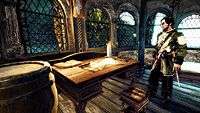 |
 |
 |
 |
 |
 |
The enemies found within the game thus far have been relatively varied, from common species such as big cats, monkeys and warthogs through to the fantastical sand devils and the cursed pirates going by the name of The Sunken Ones. Something which I found surprising, and made me smile, was that the hulking creatures being used in a lot of the promotional material (as well as the skin either side of this article) turned out to be the sand devils, which are perhaps the size of a large dog and not the overbearing beasts that I had expected them to be. Trying to fend off several at one time is certainly no easy task, but it was a surprise nonetheless to see their actual size in the preview build.
 While claw monkeys attack whenever they are approached, there are smaller monkeys resembling Macaques which can not only be captured, assuming you have enough cash and experience of course, but also trained to pick locks and steal items without arousing too much suspicion. The beauty of having this particular Dirty Trick is that by deploying the monkey you are essentially switching characters and will have full control over your simian friend, allowing you to scope out the area and survey the potential threat without putting your hero at risk. Do too much, however, and your monkey will end up becoming too conspicuous and could not only risk bringing unnecessary attention to you, but exposes your tiny companion to potential death at the hands of those being robbed.
While claw monkeys attack whenever they are approached, there are smaller monkeys resembling Macaques which can not only be captured, assuming you have enough cash and experience of course, but also trained to pick locks and steal items without arousing too much suspicion. The beauty of having this particular Dirty Trick is that by deploying the monkey you are essentially switching characters and will have full control over your simian friend, allowing you to scope out the area and survey the potential threat without putting your hero at risk. Do too much, however, and your monkey will end up becoming too conspicuous and could not only risk bringing unnecessary attention to you, but exposes your tiny companion to potential death at the hands of those being robbed.
In order to learn how to train monkeys, the player needs to have built up the Cunning attribute to level six, which is no mean feat, but this is perhaps where Risen 2 comes into its own and quietly mocks other titles in the RPG genre. In place of the traditional XP model, Dark Waters relies on the player accruing Glory, which is rewarded by completing tasks, winning challenges and mini-games, public displays of fighting skills and, of course, taking out enemies… much like the regular levelling system you’d find in any of the western role playing games. This is where the comparison ends, however.
Normally, you’d expect to reach a point where the game invites you to spend your XP on specific perks or visit an options screen but Risen 2, much like its predecessor, takes a very different approach to advancement. Your glory is spent on attributes, as you’d do with traditional XP, and each attribute has a series of talents which increase by five points every time the corresponding attribute is increased. The number of glory points required to advance increases by 1000 for every level beyond the first one, so upgrading from level two to three would cost 2000 glory points and going from four to five would be 4000 points. To shape the character in a particular direction, each talent comes with its own skill subset, all of which can be increased as long as you find someone who can teach you the skill.
 It will likely come as no surprise to discover that the aforementioned training comes at a price. A hefty price. The various trainers will not only expect to be paid a considerable fee for imparting their knowledge, but they will also have a prerequisite whereby each skill can only be taught if its main attribute has been increased to a satisfactory level. Given that glory isn’t easy to come by, and gold is rarer still, the progression of your character will undoubtedly be seen as a laborious process by those who are used to having level advancement handed to them on a gilded Imperial plate.
It will likely come as no surprise to discover that the aforementioned training comes at a price. A hefty price. The various trainers will not only expect to be paid a considerable fee for imparting their knowledge, but they will also have a prerequisite whereby each skill can only be taught if its main attribute has been increased to a satisfactory level. Given that glory isn’t easy to come by, and gold is rarer still, the progression of your character will undoubtedly be seen as a laborious process by those who are used to having level advancement handed to them on a gilded Imperial plate.
It is this gritty realism that gives the Risen series a more dedicated fan base, insofar as anyone coming to Dark Waters on the strength of the original Risen game will already be aware of the fact that they will have to work hard for every weapon, every garment, every character skill and even every single gold coin. With around fifteen hours of gameplay under my belt thus far, my character progression is akin to having played Skyrim for one or two hours and that, for me, is what places Risen 2 upon its pedestal. The developer has taken care to reward the player for devoting the time and effort rather than throwing XP around like it’s going out of fashion. It works.
 |
 |
 |
 |
 |
 |
The punishing difficulty curve is also very apparent when, during what appears to be a regular stroll through a leafy glade or the winding corridor of an ancient tomb, another of the game’s curve-balls rears its ugly head – the hidden trap. These traps take on many forms, some of which have the opportunity to fight for survival should you fail at the immediate escape route, but some will result in instant death. For example, with no visual clues to offer warning, the floor of a tomb may suddenly collapse below you with an immediate on-screen icon prompting you to hit a key or controller button to avoid falling through, but your reflexes have to be lightning fast to catch some of these or you’ll fall through the hole and almost certainly be face to face with an angry hulking beast, hell-bent on tearing you limb from limb, and that’s when the fight-or-flight instinct kicks in. Flight is generally the best option in the earlier stages of the game. In other areas, the camera will suddenly swing around to show your character becoming impaled as a rigged trap snaps up from the undergrowth like a spring-loaded crucifix, resulting in immediate death and a few suitably-sarcastic comments from your companion.
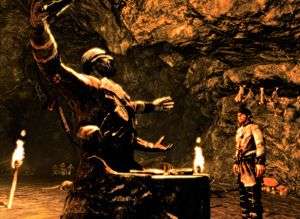 One very important point that should be mentioned is the adult nature of the dialogue, and the humour therein. At one point, during a back and forth between Captain Steelbeard and the local tavern barkeep, the aptly named Booze, Steelbeard asked “Finally crawl out of yer wanking pit, you pig shaggin’ landlubber?”, to which Booze replied “Cabin-boy-fancying old bile bag!”. Add to this the heavy usage of “fuck” by certain characters, resulting in our hero asking “You want to say ‘fuck’ a few more times, or do you want to actually fight?” and you have a game which is very obviously aimed towards a more mature audience. It’s also fair to say that, in doing so, they have captured the nature of the pirate lifestyle as I can’t imagine many would have attended finishing school.
One very important point that should be mentioned is the adult nature of the dialogue, and the humour therein. At one point, during a back and forth between Captain Steelbeard and the local tavern barkeep, the aptly named Booze, Steelbeard asked “Finally crawl out of yer wanking pit, you pig shaggin’ landlubber?”, to which Booze replied “Cabin-boy-fancying old bile bag!”. Add to this the heavy usage of “fuck” by certain characters, resulting in our hero asking “You want to say ‘fuck’ a few more times, or do you want to actually fight?” and you have a game which is very obviously aimed towards a more mature audience. It’s also fair to say that, in doing so, they have captured the nature of the pirate lifestyle as I can’t imagine many would have attended finishing school.
The dialogue throughout the game has a tendency to be somewhat tongue-in-cheek with more than a hint of sarcasm, and the voice acting varies from being considerably laid back through to an over-the-top, sitcom-style delivery. While some conversations can be noticeably hokey, they are never actually out of place so a tense situation will have a direct approach where interactions with more comedic characters will result in a more light-hearted back and forth, although there are fewer named actors than in the previous game. The main character’s voice acting could quite easily be considered as being pedestrian at times, with almost a lacklustre approach to each situation and while I imagine some would find issue with this, I personally felt that it served to further accent the fact that the guy has had enough and let himself go, so the last thing he wants is to be going back out to fight more giant creatures. Although, perhaps I’m giving the actor too much credit.
The soundtrack plays an important part in the overall immersion factor, with the harbour town having a very audible hubbub of murmured chatting, sea birds, clinking of glasses from the tavern and almost everything you’d expect to find were you actually standing there yourself. As with any well-mixed soundtrack, however, it’s neither overpowering nor is it too obvious until you actually mute the audio, and that’s when you notice how well integrated it is. Without it, the silence is deafening; with it, you hardly notice it’s there because it naturally becomes part of the scene. The score is both lilting and rousing at the same time, and contains a few familiar hooks to help carry it through. As is generally the case these days, the score also serves as an early warning system for whenever the situation is about to get a little hairy, ramping up the atmosphere with a more serious tone and turning to a Wagner-esque climactic force during any battle scene, dropping back down as the threat dissipates.
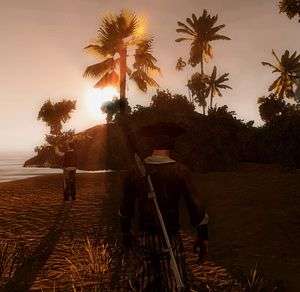 Graphically speaking, Dark Waters uses the same engine as previous Piranha Bytes titles but with some heavy tweaking on top. The textures are rich and detailed, and with a slight grain to give them another edge of realism, but the character animations are more understated than those within the original game, although I read elsewhere that the animations have been worked on since the preview build was created and they’ll be polished further prior to release. This stands to reason, as I thought the movement, fighting actions and jumping were all well executed in Risen. As with the previous game, foliage does have a tendency to grow before your eyes rather than pop on to the screen, which I imagine is down to the use of SpeedTree, but it does look good even though I suspect that the levels of detail possible within the foliage could cause havoc with lower-end PCs and will undoubtedly be trimmed down on the console versions.
Graphically speaking, Dark Waters uses the same engine as previous Piranha Bytes titles but with some heavy tweaking on top. The textures are rich and detailed, and with a slight grain to give them another edge of realism, but the character animations are more understated than those within the original game, although I read elsewhere that the animations have been worked on since the preview build was created and they’ll be polished further prior to release. This stands to reason, as I thought the movement, fighting actions and jumping were all well executed in Risen. As with the previous game, foliage does have a tendency to grow before your eyes rather than pop on to the screen, which I imagine is down to the use of SpeedTree, but it does look good even though I suspect that the levels of detail possible within the foliage could cause havoc with lower-end PCs and will undoubtedly be trimmed down on the console versions.
With everything ramped up to “Ultra” on the PC, or “High” if there is no higher setting for a particular attribute, it takes on a much more organic feel. Trees and vegetation all cast their own shadows, and the amount of available light is heavily affected by the surroundings, just as in the real world. This is great for providing essential atmosphere, especially when in dungeons or ruins as there would obviously be no natural light, but it does mean that you’re often fumbling around in the dark if you haven’t thought to take a torch with you. This was one aspect of Risen that I adored at the time, because if you’re out in a dense forest on a moonless night then you literally can’t see your hand in front of your face, so why most games would opt to falsely illuminate such scenes is beyond me. The cautiousness, the trepidation, and the sudden shit-your-pants moment when you take one more step in the darkness to find an angry warthog staring you in the face is exactly what we’d expect to find in reality, were we in a warthog-infested forest, so I want this eerie darkness in my game.
 |
 |
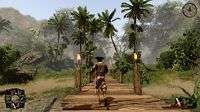 |
 |
 |
 |
Overall, Risen 2 is everything that I expected it to be, and so much more. The default high-contrast levels do take some getting used to but, taking the brightness down by the smallest increment helps to mask this odd decision by the developers, and it’s very quickly forgotten. Between the steep difficulty ramp, expensive character advancement and realistic lighting conditions, Dark Waters is by far the most brutally honest and rewarding RPG to date in terms of the risk/reward ratio; if you take the risk, and you happen to survive, the personal satisfaction is second to none… but the game itself won’t shower you with rewards. With a few graphic tweaks here and there, some optimisation for low-performance systems, it is more than a worthy successor to Risen and yet another well-deserved string to Piranha Bytes’ bow. Unless something else comes bursting out of the woodwork over the next few months, Risen 2 is a strong contender for RPG game of the year, and the two-year wait looks to have been worth it.
Risen 2: Dark Waters is due for release in North American on April 24th and Europe on April 27th.

Image shows a comparison between low settings and ultra settings on a gaming laptop running an Nvidia 460m
Last five articles by Mark R
- From Acorns to Fish
- Alone In The Dark
- Why Borderlands is Better Than Borderlands 2
- Falling Short
- The Division: A Guide to Surviving the Dark Zone Solo
















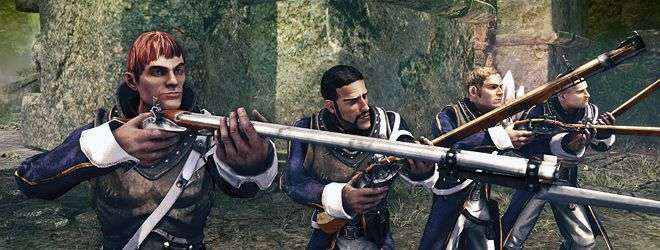
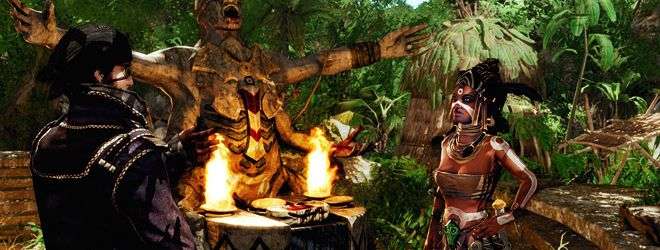






I played the first one and, at first, argued against the haters as I was enjoying the realism and challenge. But eventually the challenge and lack of reward over weighed the my fun requirement and I actually didn’t finish the game due to boredom and frustration:( I guess I won’t be picking this one up as I was hoping for more of a relaxed enjoyable sequel and opt for Witcher 2 in April and Dragons Dogma in May to fill my RPG needs.
I’m not in it for games that are overly difficult (I did my time, man), but I have to admit that part of me yearned when I saw that comparison image. I want it so, if only so I can gawp at the beautiful images on my screen. However, I need to concentrate on the games I have (and Uni!) for now.
Awesome write-up as always though
@Simon Sorry mate, been up against it lately and just catching up on the articles while I can. Risen was one of those games where, if you played it like any other RPG game, you’d fail miserably and die the entire time. I remember being a few hours in and still couldn’t get past this one particular clearing because there were wolves dotted around it and I had… a stick. Every time I tried to kill ONE wolf, the others would all start to circle and attack me, and I’d just keep dying. Same with pretty much every other bloody creature I happened upon.
It wasn’t until I learned to scenery-hop that I managed to progress through the game a bit more, and managed to power the character up enough to actually fight my way through obstacles. It took a long time though, maybe fifteen or twenty hours. Risen 2 isn’t that bad, to be honest. I’d been playing it for maybe eight hours and couldn’t kill these three natives because they had spears which could attack from a distance whereas I only had a shitty sword and a couple of guns, but the pistol reload time was terrible and the shotgun only did close range damage.
That said, I COULD have bought much better weapons but I was saving my money to buy the skill that would unlock the thieving monkey. If I had to give Risen a difficulty score out of 10, then it would be 10. From beginning to end, although perhaps by the end it dropped to an 8 with the occasional 6. Risen 2, on the other hand, starts off at between an 8 or a 9 and by the time I got to the last hour of the fifteen hours, I was able to kill most things as long as I planned my attack well and didn’t get too carried away trying to kill too many at once. I’d therefore give the difficulty a six.
I was really enjoying it though, which is quite something for me to say about a preview code that hasn’t been optimised yet and had “just a bit better than acceptable” graphics at the time. Normally I’m a graphics and performance whore, so the gameplay itself was enough to rope me in. Don’t write it off yet mate, but I wouldn’t advise picking it up until you were sure either.
@Markus. That was my problem with Risen 1. I do take pride in my RPG abilities and even do strive to complete with at least a good amount of time at the hardest difficulties (guess my achievements so for that). But I guess, as Todd Howard said in his recent keynote speech, it’s a balance of Fun Vs Challenge. At first I was enjoying the challenge even when I played hit and run against an Ogre type monster for half and hour a time cause he could 2 hit kill me, but eventually it just stop being fun both on a gameplay standpoint and on the achievement gaining front so I stopped playing. But if you are an rpg player who has got tired of easy games like Fallout and Skyrim types then I say the game is a definate. Now back to my console to play for the hard achievement on KoA; The Reckoning.